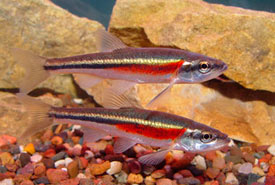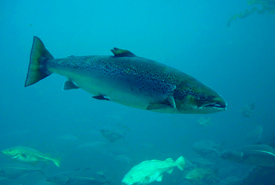Something's Fishy: Out of sight, but not out of mind

Redside dace (Photo by K. Schmidt)
The land has a magical ability to transform the way people look at nature and all it encompasses.
I used to be someone who looked for issues in our environment and assessed their level of urgency by what was in plain sight. I took this approach in my office (currently my apartment) too. The to-do list written on a fluorescent yellow sticky note, posted right above my computer, or a giant pile of laundry heaped onto my bed prompted me to deal with them with urgency.
Thanks to COVID-19, the time I’ve spent physically distancing has allowed me to see the bigger picture — from life in the city to the peace I find exploring forests across Ontario on the weekends. It wasn’t until I started really looking at the land and all the species it sustains that my perspective changed. Suddenly, importance shifted away from the problems that lay in plain sight, and instead shifted to the issues that are hidden under the surface.
Fish, to me, have always been top of mind. But for the general population, these finned friends are often hidden in plain sight, going unnoticed compared to the land mammals dominating the landscape and the birds singing and swooping overhead. In the case of freshwater fish, Canada’s conservation to-do list just got a bit longer and a lot more urgent.

Atlantic salmon (Photo by Hans-Petter Fjeld/Wikimedia Commons)
According to National Geographic, freshwater fish species are among the fastest declining species groups in the world. Migratory freshwater fish, including Atlantic salmon, are considered the most threatened fishes globally. With an average decline of the Earth’s migratory fishes of 76 per cent from 1970 to 2016, and nearly half of the world’s fish species living in fresh water, protecting these waterbodies has never been greater.
The decline of freshwater fish impacts the food available to the species that you can easily spot while out in nature, such as birds and a wide variety of mammals. Fish are also an incredibly important food source for species in the many unique and sensitive ecosystems, including the boreal, an area that encompasses close to 75 per cent of Canada’s forests and is considered Canada's largest ecosystem region.
Not only are fish essential to food webs within ecosystems across Canada and beyond its borders, they also play a critical part in the livelihoods of humans. For many First Nation communities across Canada — especially in areas where food access, systems and overall security is threatened — healthy freshwater fish are crucial for their sustainment, both physically and culturally.
In many parts of Canada, freshwater fish populations have been severely impacted by habitat degradation and pollution. One of the key steps in protecting fish populations is finding out what lies under the surface of Canada’s freshwater bodies.
The Freshwater Conservation Blueprint project is created and led by conservation staff from the Nature Conservancy of Canada’s (NCC’s) Atlantic Region. Under this project, all the rivers and streams in New Brunswick, Nova Scotia, PEI, and eastern Quebec have been mapped and assessed (along with those that feed into New Brunswick and Quebec from northern U.S.). This information is available online to the public. The goal is to use this information to improve conservation throughout the region and across borders to enable better planning and conservation across watersheds, provinces and even between Canada and the U.S. By increasing what we know about these rivers and streams, NCC, other conservation organizations and governments can use this information to manage and improve habitat for the species that live there.
By gaining valuable information from all parts of an ecosystem, including the areas beyond a quick glance, we can create more a sustainable future for landscapes and the species that live there. Awareness is key, and it’s time we take out our conservation sticky notes and add freshwater fish to the top of the to-do list.


